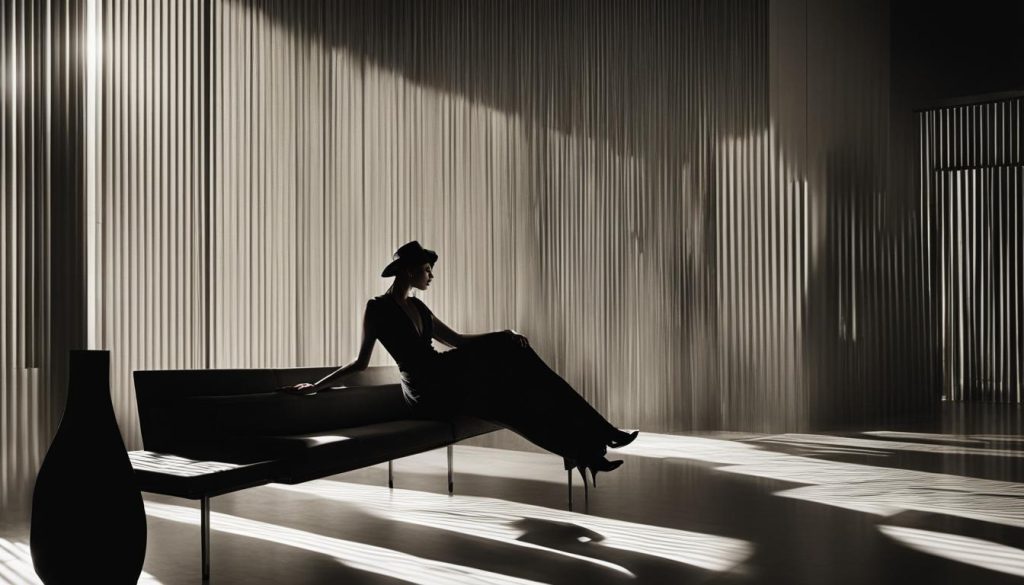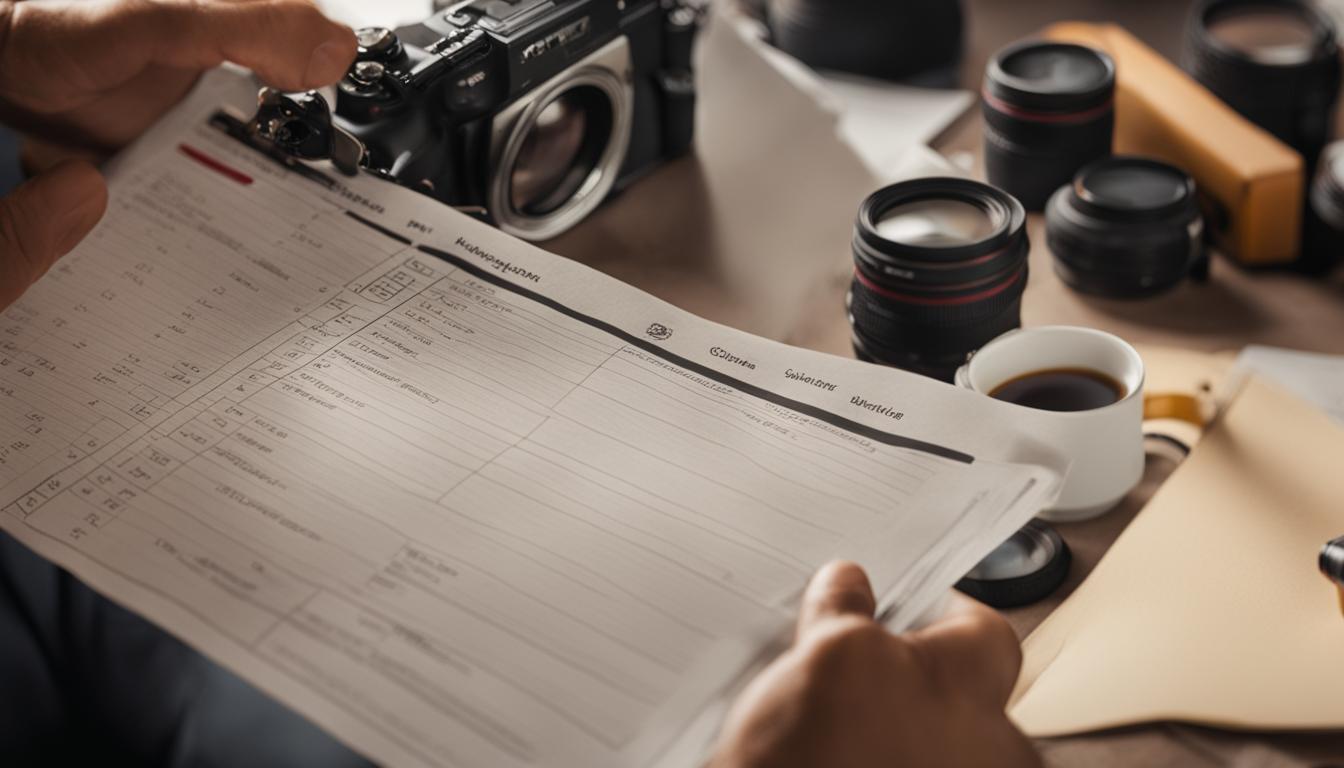Are you a photographer who wants to capture compelling editorial images that tell a story? Or maybe you’re just starting out and want to ensure you have all the necessary tools at your disposal. Whatever your situation may be, we’ve got you covered with our essential editorial photography checklist guide.
Key Takeaways:
- Our essential editorial photography checklist guide will help you capture compelling images that tell a story.
- Following our checklist, preparing for your photoshoot, mastering lighting techniques, directing your subjects, and having the right equipment are essential for success.
- Creating impactful and visually stunning images requires excellent posing and directing skills.
- Researching the concept and location, gathering the necessary equipment, and choosing the right lighting techniques are crucial for preparing for your editorial photoshoot.
- Having the right equipment and gear is essential for a successful editorial photoshoot.
Preparing for Your Editorial Photoshoot
Preparing for an editorial photoshoot is crucial for ensuring its success. Whether you’re a seasoned pro or just starting out, there are a few things you should keep in mind to avoid any last-minute mishaps.
Research Your Concept and Location
Before your photoshoot, research the concept and location thoroughly. Find inspiration by looking through magazines, social media profiles, and websites. If you’re shooting at a new location, visit it beforehand to get a feel for the space and plan your shots accordingly.
Gather Necessary Equipment
Make a list of all the equipment you’ll require and ensure that it’s clean, charged, and in working condition. If you need to rent equipment, plan for it well in advance, and make sure it’s available on the day of the shoot. Don’t forget to pack backups for essential items like batteries and memory cards.
Coordinate with Your Team
Communicate with your team, including models, makeup artists, and stylists, and provide them with a detailed schedule for the day. Ensure that everyone knows the concept and the look you are going for.
Pro Tip: If you’re shooting at an outdoor location, check the weather forecast and pack appropriate gear for you and your team.
By following these essential photo shoot preparation tips, you’ll be well on your way to ensure that everything runs smoothly on the day of your editorial photoshoot.
Mastering Lighting Techniques
Lighting can make or break editorial photography. Even the most remarkable object can appear dull and uninspiring without proper lighting. Don’t worry; we’ve got you covered. Here, in this section, we’ll introduce you to various editorial lighting techniques, and teach you how to create visually stunning images.
Natural Lighting Setups
Firstly, let’s talk about natural light setups. It is the most cost-effective and simplest way to enhance your editorial photography. Learn to use the light to your advantage by understanding the direction, timing, and coloring of natural light. This technique works best when utilized in outdoor locations with ample sunlight.

Artificial Lighting Setups
If natural light isn’t available, you can create a studio-like atmosphere by using artificial lights. Unlike natural lights, you have complete control over the intensity, color, and position of the light. This technique is essential if you have a specific vision in mind or you’re working in an indoor environment with minimal light available.
Light Modifiers for Softening and Shaping Light
Light modifiers are essential tools used to soften or shape light and remove harsh shadows. They help distribute light evenly and add dimension and depth to photos. Softboxes, umbrellas and reflectors are commonly used light modifiers. Experiment with different shapes, sizes, and colors to achieve the desired effect.
Expert Tips and Tricks for Editorial Lighting
Are you looking for some expert tips and tricks for editorial lighting? When manipulating light, there are certain techniques to keep in mind. Check out our top tips and tricks for editorial lighting here. With practice and experimentation, you’ll soon be on your way to mastering editorial lighting techniques!
Posing and Directing Your Subjects
When it comes to editorial photography, posing and directing your subjects can make all the difference in creating an impactful image. The key is to make your models feel comfortable and at ease so that their natural expressions and movements shine through.
One practical tip is to communicate with your subjects throughout the photoshoot. Let them know what you are looking for, whether it’s a particular pose or expression, and be open to their ideas. This will create a collaborative atmosphere and lead to more authentic moments that tell a story.
Another useful technique is to establish a comfortable environment by playing music or engaging in light conversation. This can help reduce tension and make your subjects feel more relaxed and confident in front of the camera.
Remember, the goal is to capture candid moments that convey a narrative, rather than stiff, unnatural poses. Take time to experiment with different angles and compositions to find the perfect shot.
Whether you’re working with professional models or everyday people, directing them with care and attention can lead to stunning editorial photography.
Equipment and Gear Essentials
When it comes to editorial photography, having the right equipment and gear is crucial. It not only helps you capture stunning images but also ensures that your workflow is smooth and efficient. Here are some essential tools and accessories that should be in your kit:
Camera and Lenses
A high-quality camera and lenses are the backbone of any successful photoshoot. Whether you prefer a DSLR or a mirrorless camera, make sure it has manual controls and shoots in RAW format. Along with the camera, carry a range of lenses to achieve different focal lengths and perspectives, such as a wide-angle lens for establishing shots or a portrait lens for close-ups.
Lighting Modifiers
Editorial photography often requires controlled lighting setups to bring out the best in your subjects and surroundings. Consider investing in lighting modifiers like umbrellas, softboxes, or diffusers to soften harsh light or create dramatic shadows. Depending on the situation, a reflector can also be useful in bouncing light back onto your subjects.
Sturdy Tripod
A sturdy tripod can come in handy in situations where you need a steady camera, such as long exposures or low light scenarios. A tripod also allows you to capture sharp images without introducing camera shake or blur.
Props and Accessories
Props and accessories can add depth and context to your images, depending on the theme of your shoot. It can include anything from flowers to books or even a vintage camera, to name a few. Make sure to carry some extra props and accessories that can enhance your creativity.
With these essential equipment and gear in your kit, you’ll be able to tackle any editorial photography challenge that comes your way.
Conclusion
As you can see, editorial photography requires careful planning and execution. By following the essential editorial photography checklist guide, preparing for your shoot, mastering lighting, directing your subjects, and having the right equipment, you will be well-prepared to capture stunning images that tell a story.
Remember, practice makes perfect, so keep honing your skills and experimenting with different techniques. With dedication, patience, and a willingness to learn, you’ll be able to achieve your editorial photography goals and produce work that you’re proud of.
Thank you for reading! We hope this guide has been helpful and wish you all the best in your editorial photography journey.






